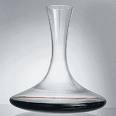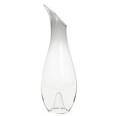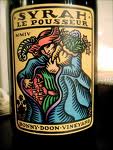|
|
 |
|
February 17, 2010
Through the holidays and up until Valentine’s Day, I had numerous occasions to reach into the wine cellar for something special. When I did I usually fetched a decanter as well, as much for the aesthetics as anything else.
There is no question that decanting a bottle of wine at the dining table contributes to the ambiance of a special occasion. The wonder is that we don’t do it more often, when we could turn an ordinary Monday night with leftovers into a memorable evening simply by treating an everyday wine as though it were special.
 Better still is the fact that decanting isn’t only for show. Most wines, even white wines, benefit from aeration. Have you ever noticed, for example, that the second half of a bottle of wine usually tastes better than the first half? Better still is the fact that decanting isn’t only for show. Most wines, even white wines, benefit from aeration. Have you ever noticed, for example, that the second half of a bottle of wine usually tastes better than the first half?
That’s because the exposure to air has softened the tannins, and the wine’s more delicate aromas have had time to flourish. This is true whether you’ve opened a $75 Barolo or a $12 Malbec. Decanting enhances the process of aeration, thus delivering more immediate results and greater pleasure from the entirety of a bottle of wine.
The size and shape of the decanter hardly matters if the alternative is no aeartion at all. But I have a few preferences in my growing collection of wine vessels, and choose the size and shape that fits the wine in intend to decant.
For example, I own a number of decnaters that are flared at the bottom; what the Italians call an onion shape. This type of decanter is perfect for young wines or tannic wines, such as Bordeaux or Barolo. The flare provides a wider surface area than more vertical decanters, giving those gripping tannins more air to make them less astringent.
If I am serving an older wine – and what you might consider old may vary with the type of wine – I prefer a more vertical decanter with less surface area. Older wines lose their primary fruit aromas over time, and what’s left of the fruit after a wine has reached 15, 20, 25 years of age is often fragile.
 A vertical decanter will better preserve the fruit than a flared decanter with a large surface area. If you cared to run an experient – possibly a very expensive and painful experiment – you could use a flared decanter to aerate a 25-year-old Bordeaux or Napa Valley Cabernet. In all likelihood the wine, if from a top producer, would taste fresh and vibrant immediately after decanting. A vertical decanter will better preserve the fruit than a flared decanter with a large surface area. If you cared to run an experient – possibly a very expensive and painful experiment – you could use a flared decanter to aerate a 25-year-old Bordeaux or Napa Valley Cabernet. In all likelihood the wine, if from a top producer, would taste fresh and vibrant immediately after decanting.
But the wine would eventually fall apart, with the fruit dying in the decanter as the evening passed – exactly the opposite of what happens with a young wine exposed to air over time.
I also have a special decanter for white wines, though generally speaking almost any decanter serves the purposes of getting air to the wine and bringing up flavors and aromas more quickly than they might otherwise evolve. My special white wine decanter has a deep punt that allows for a glass of ice that will keep whites cool for up to an hour or so.
I only use this decanter in warm weather, when I’m afraid my whites will warm too quickly and go dull.
You can spend a small fortune on a decanter, particularly if you fancy crystal from the likes of Waterford or Baccarat. Or you can waltz into any Target and buy something cheap made from regular glass. Cheap works every bit as well as expensive.
And that, like the wine itself, comes down to a matter of taste and budget.
Posted by Robert Whitley at 4:25 PM
|
|
February 11, 2010
 In recent months, I've become a devotee of so-called social media as it pertains to wine. Through a Facebook page and Twitter account, I have enlightening exchanges with the two groups — wine professionals and wine consumers — that are closest to the pulse of the commercial wine world. In recent months, I've become a devotee of so-called social media as it pertains to wine. Through a Facebook page and Twitter account, I have enlightening exchanges with the two groups — wine professionals and wine consumers — that are closest to the pulse of the commercial wine world.
Mostly, we simply share experiences and raise issues of concern that perhaps require clarification or explanation. A few examples:
Wine storage: While noting the youthfulness of a 2002 Caymus Cabernet Sauvignon I recently tasted, a Twitter follower asked how much longer I thought the wine would last. That depended, I replied, somewhat on the storage conditions. My bottle of Caymus had been kept in a refrigerated wine cabinet at sub-60 degrees Fahrenheit for its entire life. That led to a discussion about wine storage.
 I employ three methods of storage for my wine collection. Bottles for near-term drinking are kept in my wine cellar, which maintains a constant temperature between 68 degrees F and 74 degrees F. It is neither refrigerated nor humidity controlled, though I do keep an open bowl filled with distilled water on the floor at all times. I employ three methods of storage for my wine collection. Bottles for near-term drinking are kept in my wine cellar, which maintains a constant temperature between 68 degrees F and 74 degrees F. It is neither refrigerated nor humidity controlled, though I do keep an open bowl filled with distilled water on the floor at all times.
I have found that wines age more quickly under these conditions, so true "collectibles" that might have a life of 25-50 years are stored elsewhere. For that purpose, I have two refrigerated wine cabinets and lockers in two separate locations that maintain perfect humidity and temps in the 57 degrees F range. Not only do I keep young wines with long-term potential in the refrigerated storage, but also older wines that have reached full maturity, making them fragile. It is my belief the ideal conditions will prolong a wine's life at its peak.
I place wines that I don't want to be tempted to taste before their time in the off-site wine storage facilities. Those that I might want to serve for special guests in the near future are kept in the refrigerated cabinets in my garage. I also keep my vintage Champagne under refrigeration, for Champagne ages extremely well but must be kept from light and heat.
Value wines: The subject of value is an ongoing hot topic, especially among Twitter followers. Value is in the eye of the beholder, of course, and depends to some extent on the amount of money a wine enthusiast is willing to pay for a bottle of wine. Some folks have a $6 limit, others a $20 limit, and still for others $50 and up is not beyond their reach.
 No matter which price category you might fall into, there is a price point you would consider value. There is cheap wine that tastes good, and to many consumers that's value. An example of that might be the Dry Creek Vineyard Chenin Blanc, a wine that consistently wins critical acclaim but retails for less than $10 in most precincts. Then there are the slightly more expensive wines that taste like they should cost twice as much. One example would be the Ca' del Solo Le Pousseur Syrah, which carries a suggested price of $18 but generally sells for around $15. But it tastes like $30 to me! No matter which price category you might fall into, there is a price point you would consider value. There is cheap wine that tastes good, and to many consumers that's value. An example of that might be the Dry Creek Vineyard Chenin Blanc, a wine that consistently wins critical acclaim but retails for less than $10 in most precincts. Then there are the slightly more expensive wines that taste like they should cost twice as much. One example would be the Ca' del Solo Le Pousseur Syrah, which carries a suggested price of $18 but generally sells for around $15. But it tastes like $30 to me!
One of my favorite value tips is Napa Valley Merlot. Cabernet Sauvignon from Napa is often twice as much as Merlot, even from the same producer.
So even though Merlot from such big guns as Chappellet, Truchard and Clos du Val or Flora Springs might set you back $25 to $30, it's roughly half what you would pay for the equivalent Cab. Yet, you're still getting a serious red wine that delivers the weight and complexity you expect from the Napa Valley.
Wine scores: A controversial topic to say the least, there is a passionate group of purists who insist wine scores are evil. I hear them but respectfully disagree. Scores are a helpful guide to those who lack the time or the expertise to root out the best wines from the ocean of options, and for that reason, they will always be welcomed by a segment of consumers who are willing and even eager to rely upon someone else's expertise.
 The argument seems to go that scores are too precise and rigid. A bottle of wine is in a constant state of evolution, which would seem to preclude that sort of precise rating. That would be true if the score was meant to be an exact measure of a wine's quality. That's not what my scores measure. I view scores as an applaud meter. The score you see is a measure of my reaction to a specific wine at a specific moment in time. The argument seems to go that scores are too precise and rigid. A bottle of wine is in a constant state of evolution, which would seem to preclude that sort of precise rating. That would be true if the score was meant to be an exact measure of a wine's quality. That's not what my scores measure. I view scores as an applaud meter. The score you see is a measure of my reaction to a specific wine at a specific moment in time.
That said, I do take into account a wine's ability to age. I believe a score of 95 points or above should reflect not only the quality in the bottle now, but also the prospect that the wine has tremendous long-term potential. And no, this is not a perfect science. My palate and understanding of various wines from diverse parts of the world has evolved over nearly 40 years of wine tasting.
I first started collecting Bordeaux when I was 21 in 1971. If I knew then what I know now, I would still have some of those '59s and '66s. Oh, what a wine dummy I was back then!
Follow me on Twitter at www.twitter.com/wineguru.
Posted by Robert Whitley at 12:07 PM
|
|
February 3, 2010
 I make several Valentine's Day wine suggestions in this week's Creators Syndicate Wine Talk column. I have focused on wines that I believe fit the occasion, and in a broad range of prices. You might note that I have eschewed high-end Champagne. I make several Valentine's Day wine suggestions in this week's Creators Syndicate Wine Talk column. I have focused on wines that I believe fit the occasion, and in a broad range of prices. You might note that I have eschewed high-end Champagne.
You don't need me to explain a bottle of Dom will impress your date. Besides, I am well aware that profligate spending on wine is a big no-no in this economy.
From my column:
These are the times that try men's souls. Truly, for Valentine's Day is upon us and there is a general call to arms. Only a fool — or a newbie in the ways of love — would show up without a bottle of something!
Ah, but what something? That is the question. There are only two good options, which I will spell out for the Budweiser crowd. One is something bubbly, and it better not be beer. The other is something sweet, all the more impressive if accompanied by a box of chocolates.
That's the easy part. Making sense of the vast array of sparkling and sweet wines available at the corner wine shop is another matter. You get to pick your own poison, but you shouldn't be handed a blindfold and a cigarette and shoved down the Champagne aisle on your own. Any mistakes you make are likely to be very expensive!
 No need for that; sparkling wines come in a range of styles and prices. A word of caution on the bubbly, however, since a number of voices will advocate serving Champagne with chocolate. This is seldom a glorious match, for it is nearly impossible to find a Champagne or sparkling wine that is sweet enough to cope with the intensity of a decadent chocolate truffle. No need for that; sparkling wines come in a range of styles and prices. A word of caution on the bubbly, however, since a number of voices will advocate serving Champagne with chocolate. This is seldom a glorious match, for it is nearly impossible to find a Champagne or sparkling wine that is sweet enough to cope with the intensity of a decadent chocolate truffle.
That's when a truly sweet wine, such as Port, might come in handy. There are some fairly sweet sparkling styles, such as Italy's famed Asti Spumante or demi-sec Champagnges from France, but these tend to work better with cookies and pastries than rich chocolates, which overwhelm most sparkling wines. The exception might be Brachetto d'Acqui from northern Italy's Piedmont region.
Without further ado, my Valentine's Day wine suggestions. You need not settle for these alone. A good wine merchant who might not have the specific wine recommended would likely be able to produce a comparable substitute, and in matters of love, a spirit of adventure can often turn to your advantage.
For more, click here!
Posted by Robert Whitley at 9:22 AM
|
|
 |
|